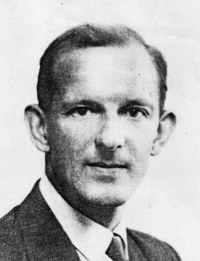|
 In
1931 Arnold ‘Skip’ Wilkins
started work at the Radio Research Station in Datchet, near Slough, where
Robert Watson Watt was superintendent. One of his first assignments was
to devise a way of measuring the angle of incidence of High Frequency (HF)
radio signals on a transatlantic telephone link from New York. In
1931 Arnold ‘Skip’ Wilkins
started work at the Radio Research Station in Datchet, near Slough, where
Robert Watson Watt was superintendent. One of his first assignments was
to devise a way of measuring the angle of incidence of High Frequency (HF)
radio signals on a transatlantic telephone link from New York. Early in
February 1935, Watson Watt left him a note asking him to calculate the HF
radio power required to raise the temperature of eight pints of water from 98°F
to 105°F at a distance of 5km and a height of 1km. Wilkins guessed that
this was about producing the heat of a fever in an airman's blood by a radio
'death ray'. Watson Watt confirmed that he had been asked by Henry
Wimperis whether it was practical to incapacitate and aircraft pilot using a
radio beam. Wilkins calculated that a radio ‘death ray’ would require an
impractically huge power - even if the airman was not screened by the metal of
the aircraft. In his conversation reporting this to Watson Watt, he did
however suggest that aircraft may be detected by the reflection of radio
waves, and cited disturbances to VHF reception caused by aircraft and noticed
by Post Office engineers. At Watson Watt's suggestion, Wilkins went on
to calculate an estimate for the magnitude of this phenomenon. This result
was reported back to the Tizard Committee which had been set up to explore
possible ways of improving air defence. Before releasing funds for
further work, Sir Hugh Dowding requested a demonstration of the ability of
aircraft to re-radiate energy in the amounts suggested by the
calculations. Wilkins proposed a experiment making using of the BBC's
Daventry transmitter and, on the morning of 26th February 1935, a Heyford
bomber flew up and down the transmitter beam. This successful
demonstration became known as the 'Daventry Experiment'. Work then started
in earnest to develop RDF (Radio Direction Finding - later called
radar). In May 1935 Wilkins was in the team that moved from Datchet to
Orfordness on the Suffolk coast. As the team expanded and more space was
needed the work moved in 1936 to nearby Bawdsey Manor. Wilkins
moved to London in the summer of 1938 with Watson Watt to help manage
deployment of the Chain Home radar system. Wilkins tells his
detailed story about the beginnings of radar in his paper 'The Early Days of
Radar in Great Britain' (see under links below). This was published in
2006 with additional notes under the title 'The Birth of British Radar' (see
under books below) and gives an excellent and interesting insight into the
genesis of radar in Britain.
Arnold Frederic 'Skip' Wilkins OBE
20 February 1907 - 5 August 1985
|